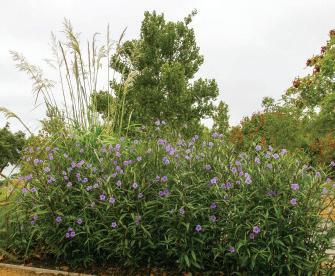Horticulture Happenings By Casey Sharber, Director of Horticulture
I
t is said that a farmer has about 40 growing seasons in which they can do their best work. Meaning a farmer has 40 opportunities to improve their harvest from one year to the next. In our case here at Myriad Gardens, each year we learn something new and work to improve the Gardens to make the visitors’ experience even better. This past year, we worked hard to achieve many lasting improvements in the gardens. Months of planning helped us achieve several project goals during a very limited and heavily scheduled time period – spring!
GREAT LAWN TREES
One of the first projects we undertook was to replace the 48 trees on the Great Lawn. Originally planted with Shantung hybrid maple trees that were suffering from a condition called Southwest injury, we replaced them with ‘Green Vase’ Zelkovas. Finding 48 large trees that looked similar in size was no easy feat and involved a nationwide search. After sourcing some larger ones in Georgia and some slightly smaller ones here locally we decided to go with the local ones, knowing that a local tree is more resistant to local conditions (weather, insects, disease, etc.) and that a slightly smaller tree would handle transplanting better than a larger tree. Tree anchoring systems were also purchased in advance in order to stabilize the newly planted trees without the imposing stakes and guywires that you often see on newly planted trees. We are happy to report that all the trees are doing well and will continue to provide more shade along the sidewalks and perimeter of the Great Lawn for years to come.
PRAIRIE GARDEN
Many of the plants for this garden were pre-ordered in 2014 and while often prairies are seeded when being established we wanted a more immediate impact and planted larger rooted plants. The grasses that were a bit easier to source were mainly in 1 gallon containers but went up to five gallon containers, while the wide array of herbaceous flowering perennials were mainly two inch plugs, quarts, or one gallon containers. There are pros and cons to a small plant verses a larger plant including cost and ease of planting, but the biggest factor is the watering and with such a mix of plant sizes it was even more critical to be cautious not to let the small plugs dry out in such a large planting bed. Fortunately for us, we got the prairie and pollinator garden planted the first week of May and it seemed to rain every few days after for the rest of the month.
5 and if you look at it now you would We are very excited about this new garden never guess that some of those plants started out as plugs not much larger than your thumb. The butterflies do not seem to notice and seem to be loving their new home. The Prairie Garden would not be possible without the generous support of the Kirkpatrick Family Fund and Stanley Smith Horticultural Trust. Pictured left: Black Eyed Susan. Rudbeckia subtomenntosa, Henry Eilers. Photo by Doug Hoke.
7






